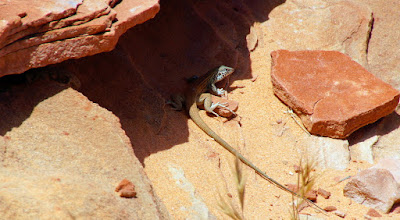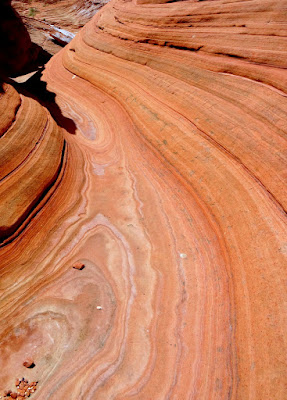On the Page side of the Glen Canyon dam a small brown hikers sign points to an otherwise unmarked gravel road. A few hundred yards down the road is parking for the Hanging Gardens hike which we did a few days ago. If you continue down the hill to the left from that parking area another unpaved road leads to a larger parking area a quarter mile closer to the water.
We heard it referred to as "The Chains" trail but we never saw any signs and we never found it on any maps. We also did not find a "trail". What we did find was a fantastic landscape of swirling sandstone. We were free to roam in any direction we chose and we covered as much as we could. I should note that if the lake were at full pool a lot of what we saw would be underwater so it might look significantly different the next time we visit.
A fellow traveler once told us, "deliver me from ever seeing another red rock." I can't say I feel the same way, they continue to fascinate me.
The different colors, except white, are due to varying mixtures of hematite, goethite, and limonite that oozed within spaces between quartz grains.
Variations in the type and amounts of iron oxides resulted in the different black, brown, crimson, vermillion, orange, salmon, peach, pink, gold, and yellow colors of the Navajo Sandstone.
These concretions called "Moqui Marbles" have a fun connection with Mars. Apparently, Opportunity rover found similar marbles at Meridiani Planum on Mars, named "Martian Blueberries" or more technically "Martian Spherules."
A: It's sometimes referred to as the 'bathtub ring' and is caused by the calcium carbonate and other hard minerals in the water that attach themselves to the sandstone leaving behind a white mark. The top of the white mark is the high water mark.
Swimming is allow, but it's not recommended for children. It is shallow for a few feet and then drops off to 500 feet deep.
Another "spherical reduction?" I'm still looking for a clear explanation for this phenomenon.




















No comments:
Post a Comment